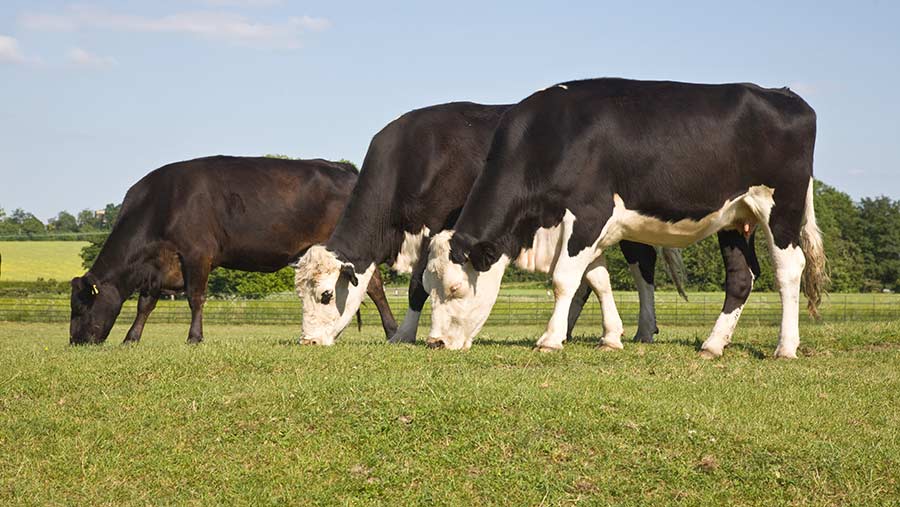How an Irish farmer is achieving in-calf rate of 91% with AI
 © Tim Scrivener
© Tim Scrivener Matthew Murphy is farm manager at Newford Farm, Athenry in County Galway, which was set up as a demonstration farm in 2015 by Dawn Meats and the Irish agriculture and food development authority, Teagasc.
The 100-cow spring-calving suckler herd is grass based and runs over 66ha.
Herd replacements are sourced from dairy farms and while these animals provide good maternal traits such as milk and docility, their beef characteristics often let them down, said Mr Murphy.
See also: How beef farmer is achieving gross margin of £370 a cow
In order to reach their targets of 80% of progeny finished off grass at 20 months, they are using AI to maximise terminal traits.
Speaking at the British Cattle Breeders Conference on Tuesday 24 January, Mr Murphy described how he was using 100% AI across the herd and achieving an in-calf rate of 91% in 11 weeks.
1. Getting the cows in good condition
Having cows in the right body condition score is key to good fertility, said Mr Murphy.
Therefore, at housing in November, cows are condition scored and penned in groups accordingly, with extra feed allocated to those in poorer condition.
This year, 36 cows received 3kg a head a day of soya hulls from November until mid-January.
After calving all animals go straight out to spring grass which is high in energy to get them cycling again.
Target: BCS 3-3.5 at calving
Farm facts
- 100 Hereford and Angus cross Friesian suckler cows, sourced from dairy farms
- 66ha
- Heifers contract reared and come back to the holding in calf at 20 months old
- A student taken on for three months in the spring during calving
- Uses Charolais, Simmental and Limousin sires, but terminal figures more important than breed for selection
- Calving February to April
- Calves creep fed
- In 2018, 61 steers were sold at 21 months weighing 685kg and they killed out at 54% at R= 3+ at a base price of €3.75/kg. This has increased from 332kg in 2016.
2. Recording heats
Cows are tail-painted, and three weeks before breeding they are checked four to five times daily and tag numbers are recorded to ensure they are showing heats before the start of breeding on 24 April.
“I take a notebook and observe heats and get the vet out to check cows that are not cycling. It’s the most important time of the year and you won’t find me anywhere else but looking at cows in May and June,” explained Mr Murphy.
Last season eight cows were seen by the vet and it is this attention to detail that is helping the herd achieve such good fertility results.
“If I was not looking, that could have been eight cows more that weren’t in-calf at scanning,” added Mr Murphy.
3. Using a vasectomised bull
Two vasectomised Friesian bulls are run with each group of 50 cows. A chin-ball harness with paint is fitted to each bull (this leaves a paint mark on the rump of the cow when the teaser is mounting the cow or resting his head on her rump).
At €850 a head (£736) they are an extremely cost-effective way to pick up heats and only cost €30 (£26) to run for 10 weeks when taking into account slaughter price values.
4. Using once-a-day AI
Cows are served at noon every day so it means animals only have to be brought inside once a day.
All AI is carried out by Mr Murphy: “If a cow is in standing heat in the evening or morning, she is served at noon. If she is still showing standing heat in the evening after being inseminated earlier in the day, she receives another AI straw the following morning.”
Although Mr Murphy concedes 18 cows were repeat served under this method, at a cost of £10/straw this only cost £180, which he views as a saving in comparison to the extra labour it would cost to serve cows twice a day.
5. Bull selection
The selection of an easy-calving sire is crucial to fertility, believes Mr Murphy, who carefully selects bulls using genetic evaluations from the Irish Cattle Breeding Federation.
He filters out the bulls with the following desired estimated breeding values (EBVs)
- Five-star terminal index
- More than 80% reliability
- Less than 7% calving difficulty for mature cows
- More than 30kg predicted carcass weight for mature cows
- Less than 6% calving difficulty for first and second calvers
- More than 25kg predicted carcass weight for first and second calvers
- Straws costs less than €15
